
Freight delivery company Werner (NASDAQ: WERN) announced better-than-expected revenue in Q3 CY2025, with sales up 3.5% year on year to $771.5 million. Its non-GAAP loss of $0.03 per share was significantly below analysts’ consensus estimates.
Is now the time to buy Werner? Find out by accessing our full research report, it’s free for active Edge members.
Werner (WERN) Q3 CY2025 Highlights:
- Revenue: $771.5 million vs analyst estimates of $764.2 million (3.5% year-on-year growth, 1% beat)
- Adjusted EPS: -$0.03 vs analyst estimates of $0.13 (significant miss)
- Adjusted EBITDA: $59.16 million vs analyst estimates of $88.28 million (7.7% margin, 33% miss)
- Operating Margin: -1.7%, down from 2.4% in the same quarter last year
- Free Cash Flow was $79.38 million, up from -$26.87 million in the same quarter last year
- Market Capitalization: $1.61 billion
Company Overview
Conducting business in over a 100 countries, Werner (NASDAQ: WERN) offers full-truckload, less-than-truckload, and intermodal delivery services.
Revenue Growth
Reviewing a company’s long-term sales performance reveals insights into its quality. Any business can have short-term success, but a top-tier one grows for years. Regrettably, Werner’s sales grew at a tepid 4.7% compounded annual growth rate over the last five years. This fell short of our benchmark for the industrials sector and is a poor baseline for our analysis.
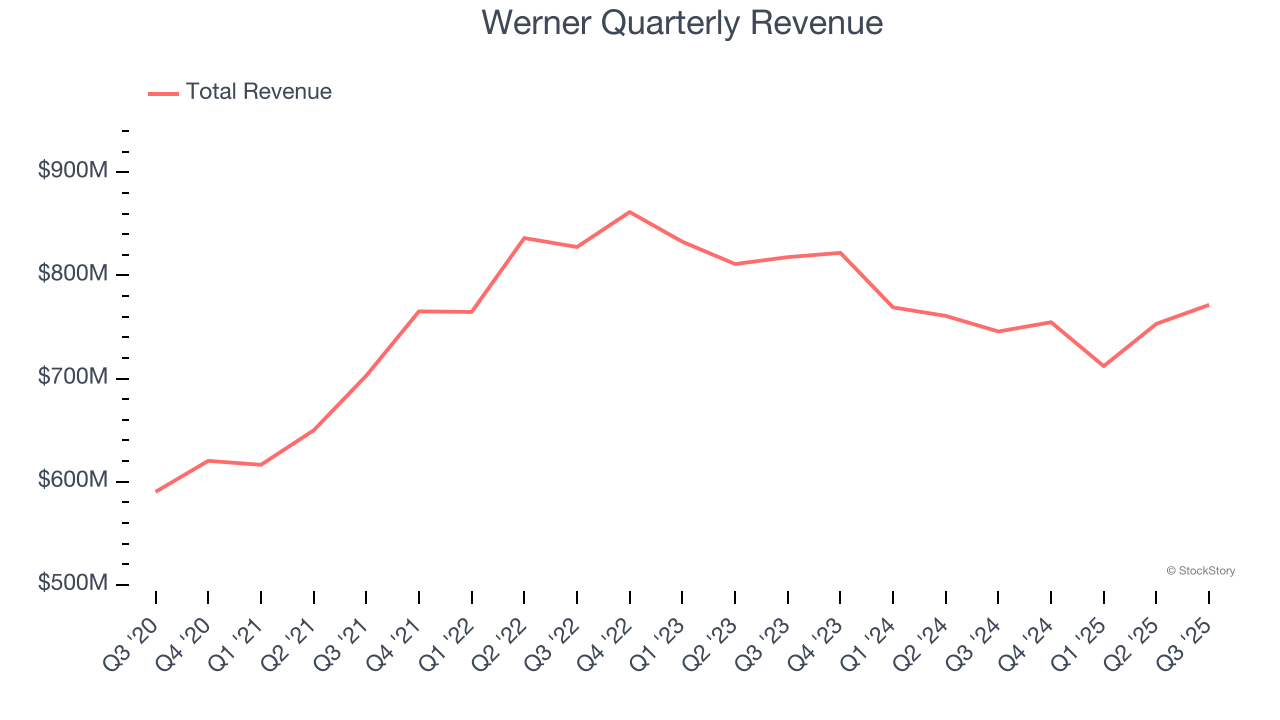
We at StockStory place the most emphasis on long-term growth, but within industrials, a half-decade historical view may miss cycles, industry trends, or a company capitalizing on catalysts such as a new contract win or a successful product line. Werner’s performance shows it grew in the past but relinquished its gains over the last two years, as its revenue fell by 5.1% annually. Werner isn’t alone in its struggles as the Ground Transportation industry experienced a cyclical downturn, with many similar businesses observing lower sales at this time. 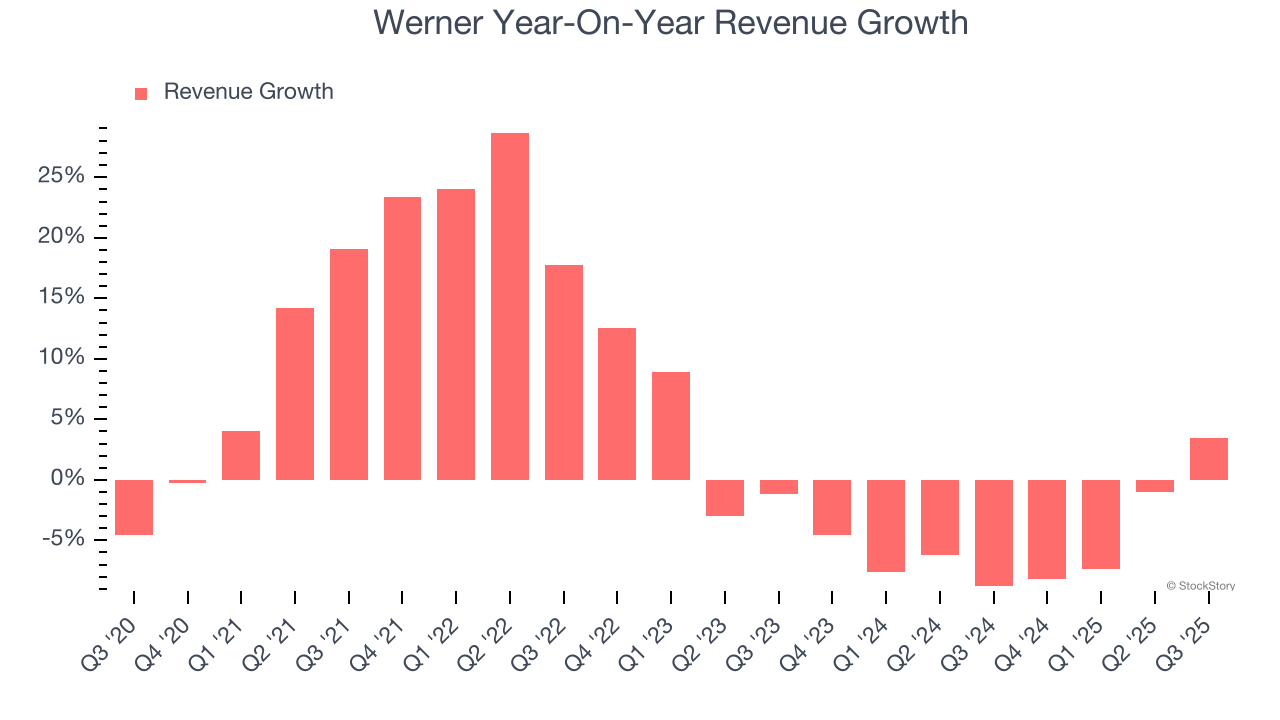
Werner also breaks out the revenue for its most important segments, Truckload Transportation and Logistics, which are 67.4% and 30.1% of revenue. Over the last two years, Werner’s Truckload Transportation revenue (deliveries made with Werner's fleet) averaged 6.5% year-on-year declines while its Logistics revenue (brokered deliveries using third-party fleets) averaged 1.7% declines. 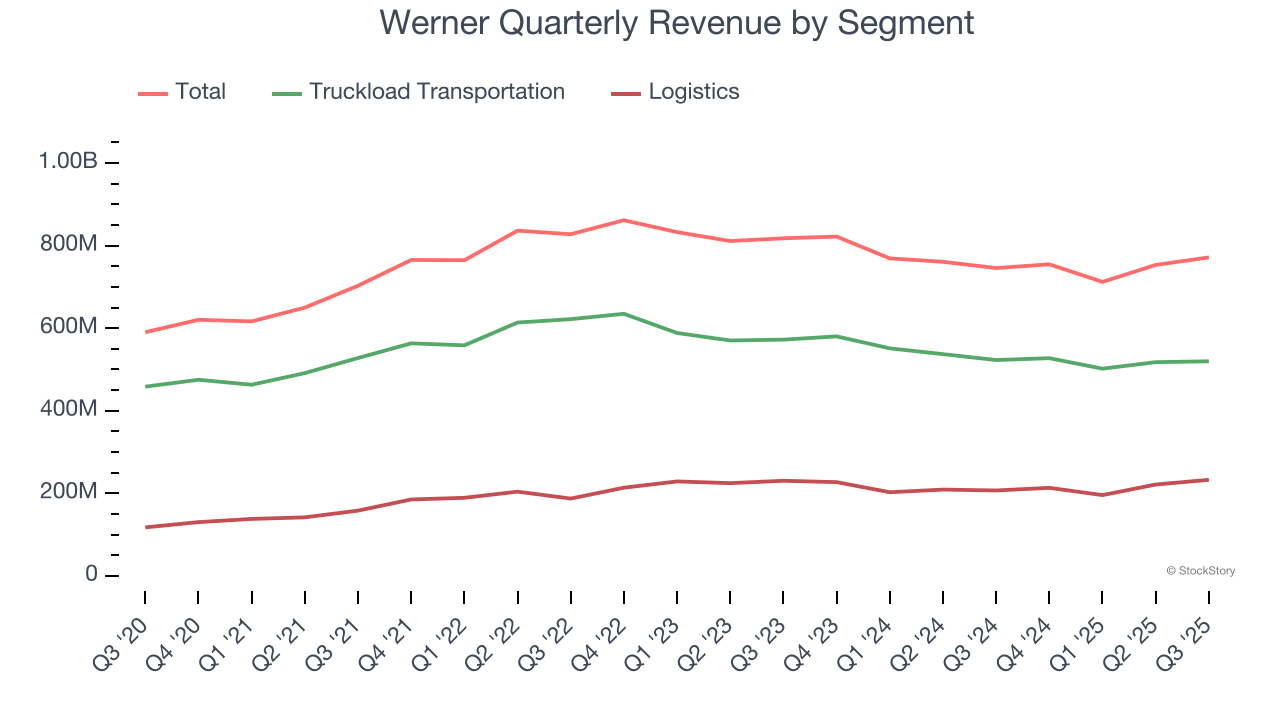
This quarter, Werner reported modest year-on-year revenue growth of 3.5% but beat Wall Street’s estimates by 1%.
Looking ahead, sell-side analysts expect revenue to grow 4.2% over the next 12 months. Although this projection indicates its newer products and services will fuel better top-line performance, it is still below the sector average.
Today’s young investors won’t have read the timeless lessons in Gorilla Game: Picking Winners In High Technology because it was written more than 20 years ago when Microsoft and Apple were first establishing their supremacy. But if we apply the same principles, then enterprise software stocks leveraging their own generative AI capabilities may well be the Gorillas of the future. So, in that spirit, we are excited to present our Special Free Report on a profitable, fast-growing enterprise software stock that is already riding the automation wave and looking to catch the generative AI next.
Operating Margin
Werner was profitable over the last five years but held back by its large cost base. Its average operating margin of 6.6% was weak for an industrials business. This result isn’t too surprising given its low gross margin as a starting point.
Analyzing the trend in its profitability, Werner’s operating margin decreased by 9.2 percentage points over the last five years. This raises questions about the company’s expense base because its revenue growth should have given it leverage on its fixed costs, resulting in better economies of scale and profitability. We’ve noticed many Ground Transportation companies also saw their margins fall (along with revenue, as mentioned above) because the cycle turned in the wrong direction, but Werner’s performance was poor no matter how you look at it. It shows that costs were rising and it couldn’t pass them onto its customers.
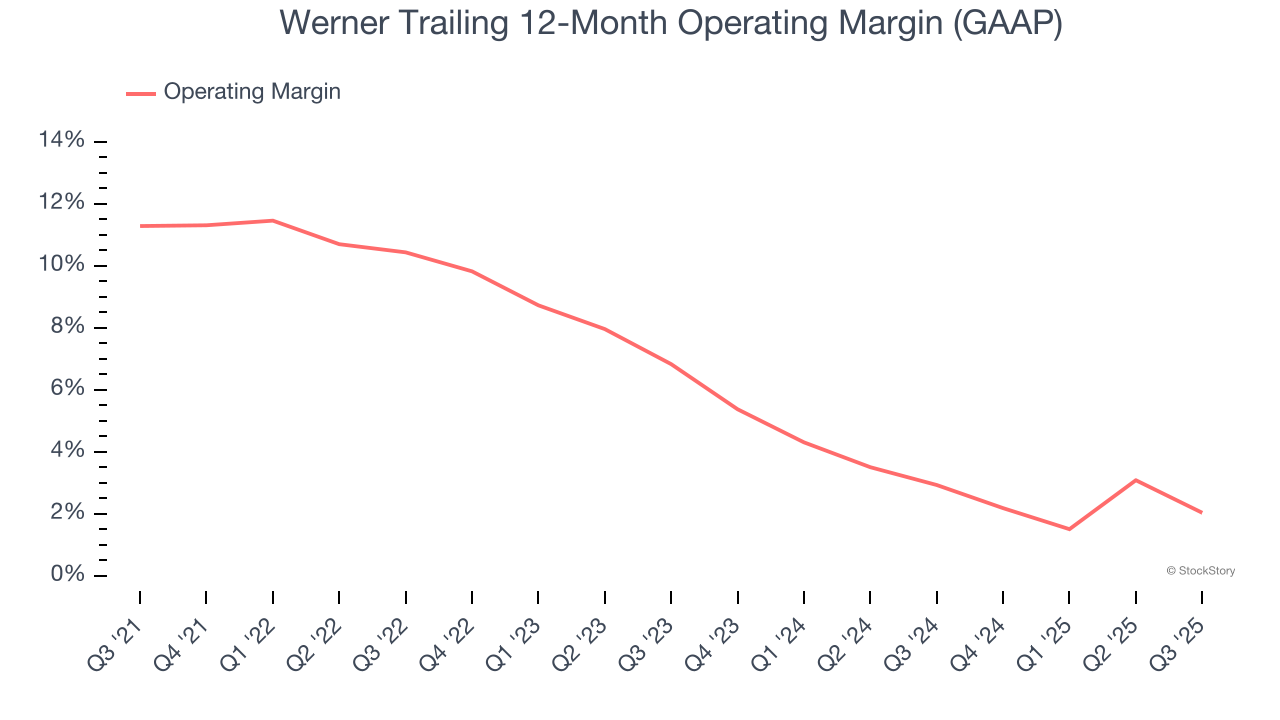
This quarter, Werner generated an operating margin profit margin of negative 1.7%, down 4 percentage points year on year. Conversely, its revenue and gross margin actually rose, so we can assume it was less efficient because its operating expenses like marketing, R&D, and administrative overhead grew faster than its revenue.
Earnings Per Share
We track the long-term change in earnings per share (EPS) for the same reason as long-term revenue growth. Compared to revenue, however, EPS highlights whether a company’s growth is profitable.
Sadly for Werner, its EPS declined by 55.8% annually over the last five years while its revenue grew by 4.7%. This tells us the company became less profitable on a per-share basis as it expanded due to non-fundamental factors such as interest expenses and taxes.
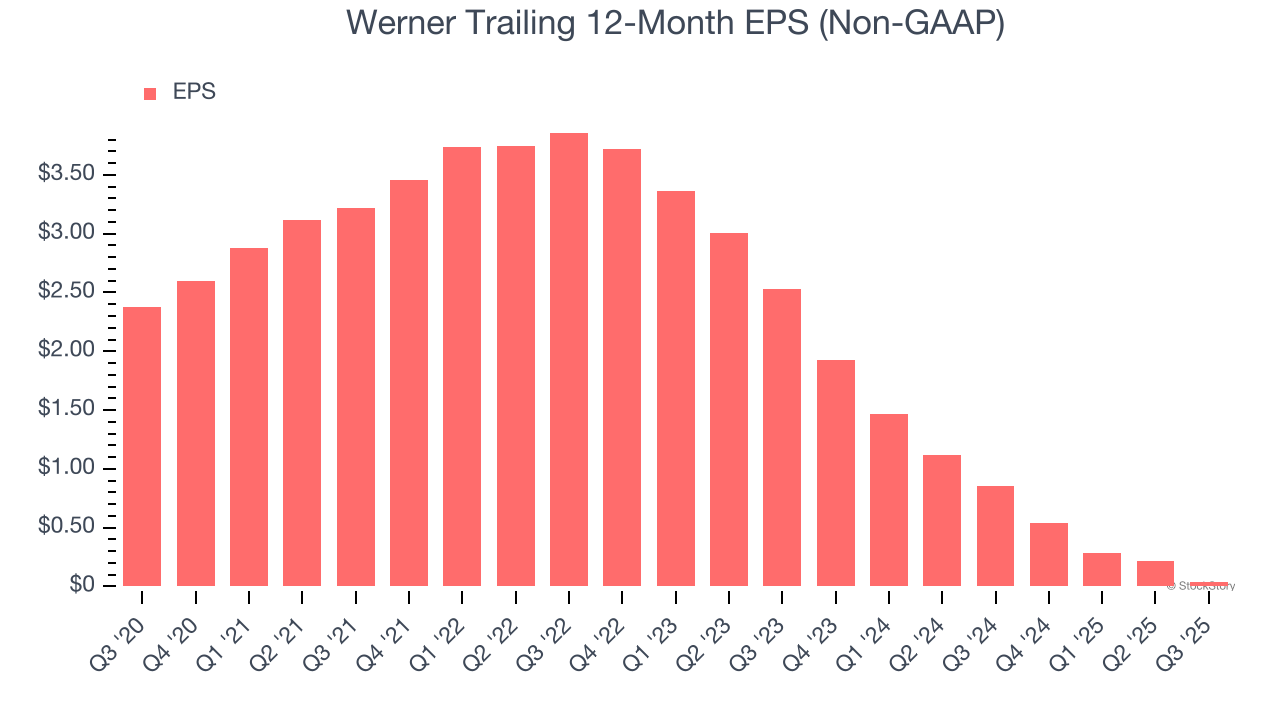
Diving into the nuances of Werner’s earnings can give us a better understanding of its performance. As we mentioned earlier, Werner’s operating margin declined by 9.2 percentage points over the last five years. This was the most relevant factor (aside from the revenue impact) behind its lower earnings; interest expenses and taxes can also affect EPS but don’t tell us as much about a company’s fundamentals.
Like with revenue, we analyze EPS over a shorter period to see if we are missing a change in the business.
For Werner, its two-year annual EPS declines of 87.4% show it’s continued to underperform. These results were bad no matter how you slice the data.
In Q3, Werner reported adjusted EPS of negative $0.03, down from $0.15 in the same quarter last year. This print missed analysts’ estimates. Over the next 12 months, Wall Street expects Werner’s full-year EPS of $0.04 to grow 2,143%.
Key Takeaways from Werner’s Q3 Results
We were also happy its revenue narrowly outperformed Wall Street’s estimates. On the other hand, its adjusted operating income missed and its EBITDA fell short of Wall Street’s estimates. Overall, this quarter could have been better. The stock traded down 1.1% to $25.10 immediately following the results.
Werner’s earnings report left more to be desired. Let’s look forward to see if this quarter has created an opportunity to buy the stock. We think that the latest quarter is only one piece of the longer-term business quality puzzle. Quality, when combined with valuation, can help determine if the stock is a buy. We cover that in our actionable full research report which you can read here, it’s free for active Edge members.







